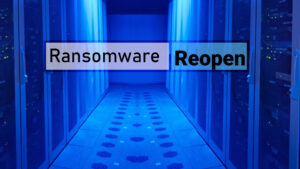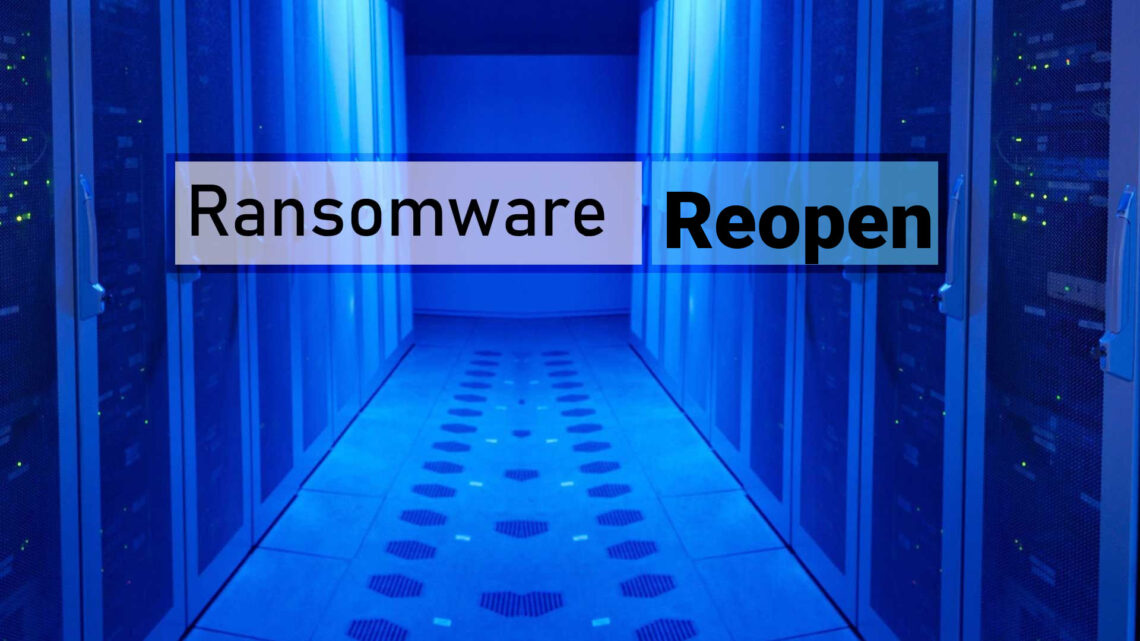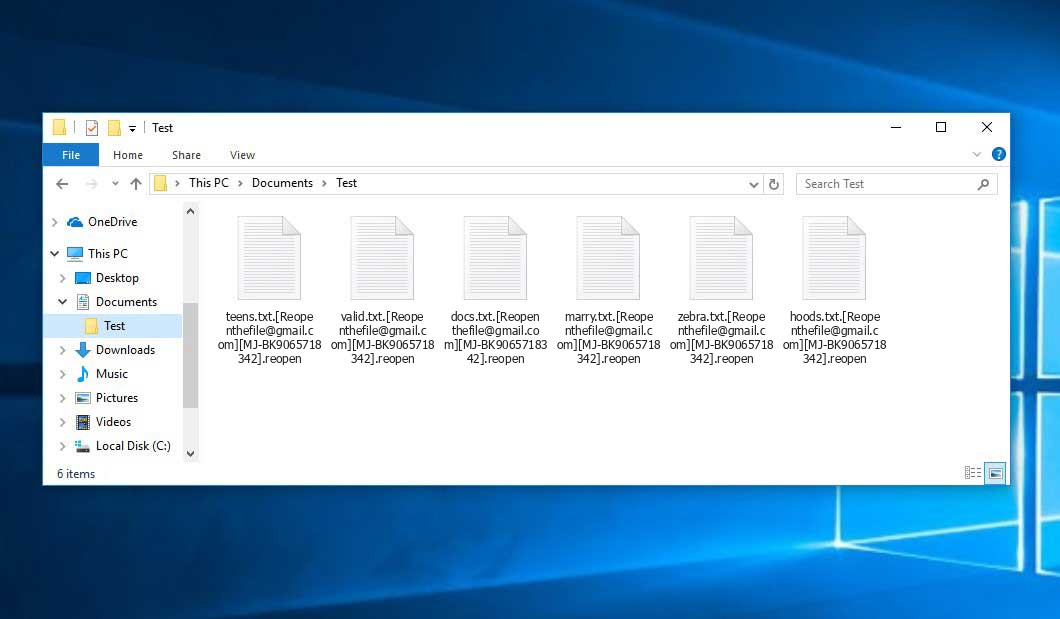The Reopen virus belongs to the VoidCrypt ransomware family. Harmful software of this type encrypts all user’s data on the PC (photos, documents, excel sheets, music, videos, etc) and appends its extra extension to every file, leaving the INFORMATION.txt text files in each directory with the encrypted files.
Reopen virus: what is known so far?
☝️ A scientifically correct description for the Reopen is “a VoidCrypt family ransomware-type infection”.
The pattern of renaming is the following: [contact-email][victim_ID].reopen. In the process of encryption, a file entitled, for example, “report.docx” will be renamed to “report.docx.[Reopenthefile@gmail.com][MJ-BK9065718342].reopen”.
In every directory containing the encoded files, a INFORMATION.txt text file will be found. It is a ransom money note. Therein you can find information about the ways of paying the ransom and some other information. The ransom note most probably contains instructions on how to buy the decryption tool from the ransomware developers. You can obtain this decoding tool after contacting Reopenthefile@gmail.com through email. That is it.
Reopen abstract:
| Name | Reopen Virus |
| Ransomware family1 | VoidCrypt ransomware |
| Extension | .reopen |
| Ransomware note | INFORMATION.txt |
| Contact | Reopenthefile@gmail.com |
| Detection | Crytex.Virus.FileInfector.DDS, Win32/Filecoder.OLC, Malware-Cryptor.InstallCore.5 |
| Symptoms | Your files (photos, videos, documents) get a .reopen extension and you can’t open them. |
| Fix Tool | See If Your System Has Been Affected by Reopen virus |
The INFORMATION.txt document coming in package with the Reopen malware provides the following dispiriting information:
Your Files Are Has Been Locked Your Files Has Been Encrypted with cryptography Algorithm If You Need Your Files And They are Important to You, Dont be shy Send Me an Email Send Test File + The Key File on Your System (File Exist in C:/ProgramData example : KEY-SE-24r6t523 or RSAKEY.KEY) to Make Sure Your Files Can be Restored Make an Agreement on Price with me and Pay Get Decryption Tool + RSA Key AND Instruction For Decryption Process Attention: 1- Do Not Rename or Modify The Files (You May loose That file) 2- Do Not Try To Use 3rd Party Apps or Recovery Tools ( if You want to do that make an copy from Files and try on them and Waste Your time ) 3-Do not Reinstall Operation System(Windows) You may loose the key File and Loose Your Files 4-Do Not Always Trust to Middle mans and negotiators (some of them are good but some of them agree on 4000usd for example and Asked 10000usd From Client) this Was happened Your Case ID : - Our Email:Reopenthefile@gmail.com
In the image below, you can see what a directory with files encrypted by the Reopen looks like. Each filename has the “.reopen” extension added to it.
How did my machine catch Reopen ransomware?
There are plenty of possible ways of ransomware infiltration.
Nowadays, there are three most exploited ways for hackers to have ransomware working in your system. These are email spam, Trojan injection and peer file transfer.
If you open your mailbox and see emails that look like familiar notifications from utility services companies, postal agencies like FedEx, Internet providers, and whatnot, but whose addresser is unknown to you, beware of opening those letters. They are most likely to have a malware file enclosed in them. Thus it is even more dangerous to download any attachments that come with emails like these.
Another thing the hackers might try is a Trojan virus scheme2. A Trojan is an object that infiltrates into your machine disguised as something legal. For instance, you download an installer of some program you want or an update for some service. But what is unpacked turns out to be a harmful program that encrypts your data. As the update wizard can have any name and any icon, you’d better be sure that you can trust the source of the things you’re downloading. The best way is to use the software companies’ official websites.
As for the peer networks like torrents or eMule, the danger is that they are even more trust-based than the rest of the Internet. You can never know what you download until you get it. Our suggestion is that you use trustworthy websites. Also, it is reasonable to scan the folder containing the downloaded objects with the antivirus as soon as the downloading is done.
How to remove the Reopen virus?
It is important to note that besides encrypting your data, the Reopen virus will probably install the Azorult Spyware on your PC to seize your credentials to different accounts (including cryptocurrency wallets). That program can derive your credentials from your browser’s auto-filling data.
Sometimes racketeers would decode some of your files to prove that they indeed have the decryption program. As Reopen virus is a relatively recent ransomware, safety measures engineers have not yet found a way to reverse its work. However, the decryption instruments are frequently updated, so the solution may soon be available.
Sure thing, if the hackers succeed in encrypting someone’s critical data, the hopeless person will most likely comply with their demands. However, paying a ransom does not necessarily mean that you’re getting your blocked information back. It is still risky. After getting the ransom, the racketeers may deliver a wrong decryption key to the injured party. There were reports about malefactors simply disappearing after getting the ransom without even writing back.
The best solution against ransomware is to have aan OS restore point or the copies of your essential files in the cloud storage or at least on an external drive. Surely, that might be insufficient. Your most important thing could be that one you were working on when it all went down. But at least it is something. It is also wise to scan your PC for viruses with the antivirus program after the system is rolled back.
Reopen is not the only ransomware of its kind, since there are other specimens of ransomware out there that act in the same manner. Examples of those are Iotr, Hhoo, Hhee, and some others. The two basic differences between them and the Reopen are the ransom amount and the encoding method. The rest is almost identical: documents become blocked, their extensions altered, ransom notes emerge in every folder containing encoded files.
Some lucky victims were able to decrypt the blocked files with the help of the free software provided by anti-ransomware developers. Sometimes the hackers accidentally send the decryption code to the wronged in the ransom readme. Such an extraordinary fail allows the victim to restore the files. But naturally, one should never expect such a chance. Make no mistake, ransomware is a bandits’ technology to lay their hands on the money of their victims.
How to avert ransomware attack?
Reopen ransomware has no superpower, neither does any similar malware.
You can armour your computer from ransomware injection taking several easy steps:
- Never open any letters from unknown mailboxes with unknown addresses, or with content that has likely no connection to something you are waiting for (how can you win in a money prize draw without even taking part in it?). In case the email subject is likely something you are expecting, scrutinize all elements of the dubious email carefully. A fake email will always have a mistake.
- Do not use cracked or untrusted programs. Trojan viruses are often spreaded as a part of cracked software, possibly as a “patch” which prevents the license check. But potentially dangerous programs are very hard to tell from trustworthy ones, as trojans may also have the functionality you need. Try to find information on this software product on the anti-malware forums, but the optimal solution is not to use such software.
- And finally, to be sure about the safety of the objects you downloaded, use GridinSoft Anti-Malware. This software will be a powerful armor for your personal computer.
Reasons why I would recommend GridinSoft3
There is no better way to recognize, remove and prevent ransomware than to use an anti-malware software from GridinSoft4.
Download Removal Tool.
You can download GridinSoft Anti-Malware by clicking the button below:
Run the setup file.
When setup file has finished downloading, double-click on the setup-antimalware-fix.exe file to install GridinSoft Anti-Malware on your system.

An User Account Control asking you about to allow GridinSoft Anti-Malware to make changes to your device. So, you should click “Yes” to continue with the installation.

Press “Install” button.

Once installed, Anti-Malware will automatically run.

Wait for the Anti-Malware scan to complete.
GridinSoft Anti-Malware will automatically start scanning your computer for Reopen infections and other malicious programs. This process can take a 20-30 minutes, so I suggest you periodically check on the status of the scan process.

Click on “Clean Now”.
When the scan has finished, you will see the list of infections that GridinSoft Anti-Malware has detected. To remove them click on the “Clean Now” button in right corner.

FAQ
🤔 Are the “.reopen” files accessible?
Negative. That is why ransomware is so frustrating. Until you decode the “.reopen” files you will not be able to access them.
🤔 What should I do to make my files accessible as fast as possible?
Hopefully, you have made a copy of those important files. If not, there is still a function of System Restore but it needs a Restore Point to be previously saved. The rest of the methods require patience.
🤔 You have advised using GridinSoft Anti-Malware to get rid of the Reopen virus. Does it mean that all my files, currently encrypted, will be removed too?
No way! Unlike the ransomware program itself, the encrypted files do not jeopardize your system.
GridinSoft Anti-Malware will delete the threats from your computer. The ransomware that has attacked your system is probably still functional and launching checks every so often to encode any new files you might create on your computer after the infection. As it has already been said, the Reopen ransomware does not come alone. It installs backdoors and keyloggers that can steal your account credentials and provide criminals with easy access to your computer in the future.
🤔 What to do if the Reopen virus has blocked my PC and I can’t get the activation code.
In such an unfortunate situation, you need to have a flash memory card with a previously installed Trojan Killer. Use Safe Mode to perform the procedure. The point is that the ransomware starts automatically as the system boots and encodes any new files created or imported into your system. To stop this function – use Safe Mode, which allows only the vital applications to run upon system boot. Consider reading our manual on running Windows in Safe Mode.
🤔 And what should I do now?
Many of the blocked files might still be within your reach
- If you sent or received your important files via email, you could still download them from your online mailbox.
- You may have shared images or videos with your friends or family members. Just ask them to post those images back to you.
- If you have initially got any of your files from the Web, you can try downloading them again.
- Your messengers, social networks pages, and cloud disks might have all those files as well.
- It might be that you still have the needed files on your old computer, a notebook, mobile, memory stick, etc.
HINT: You can employ file recovery utilities5 to retrieve your lost information since ransomware encodes the copies of your files, deleting the authentic ones. In the video below, you can see how to recover your files with PhotoRec, but remember: you won’t be able to do it before you remove the ransomware itself with an anti-malware program.
Also, you can contact the following governmental fraud and scam sites to report this attack:
- In the United States: On Guard Online;
- In Canada: Canadian Anti-Fraud Centre;
- In the United Kingdom: Action Fraud;
- In Australia: SCAMwatch;
- In New Zealand: Consumer Affairs Scams;
- In France: Agence nationale de la sécurité des systèmes d’information;
- In Germany: Bundesamt für Sicherheit in der Informationstechnik;
- In Ireland: An Garda Síochána;
To report the attack, you can contact local executive boards. For instance, if you live in USA, you can have a talk with FBI Local field office, IC3 or Secret Service.
I need your help to share this article.
It is your turn to help other people. I have written this guide to help users like you. You can use the buttons below to share this on your favorite social media Facebook, Twitter, or Reddit.
Brendan SmithHow to Remove REOPEN Ransomware & Recover PC

Name: REOPEN Virus
Description: REOPEN Virus is a ransomware-type infections. This virus encrypts important personal files (video, photos, documents). The encrypted files can be tracked by a specific .reopen extension. So, you can't use them at all.
Operating System: Windows
Application Category: Virus
User Review
( votes)References
- My files are encrypted by ransomware, what should I do now?
- You can read more on Trojans, their use and types in the Trojan-dedicated section of GridinSoft official website.
- GridinSoft Anti-Malware Review from HowToFix site: https://howtofix.guide/gridinsoft-anti-malware/
- More information about GridinSoft products: https://gridinsoft.com/comparison
- Here’s the list of Top 10 Data Recovery Software Of 2023.



